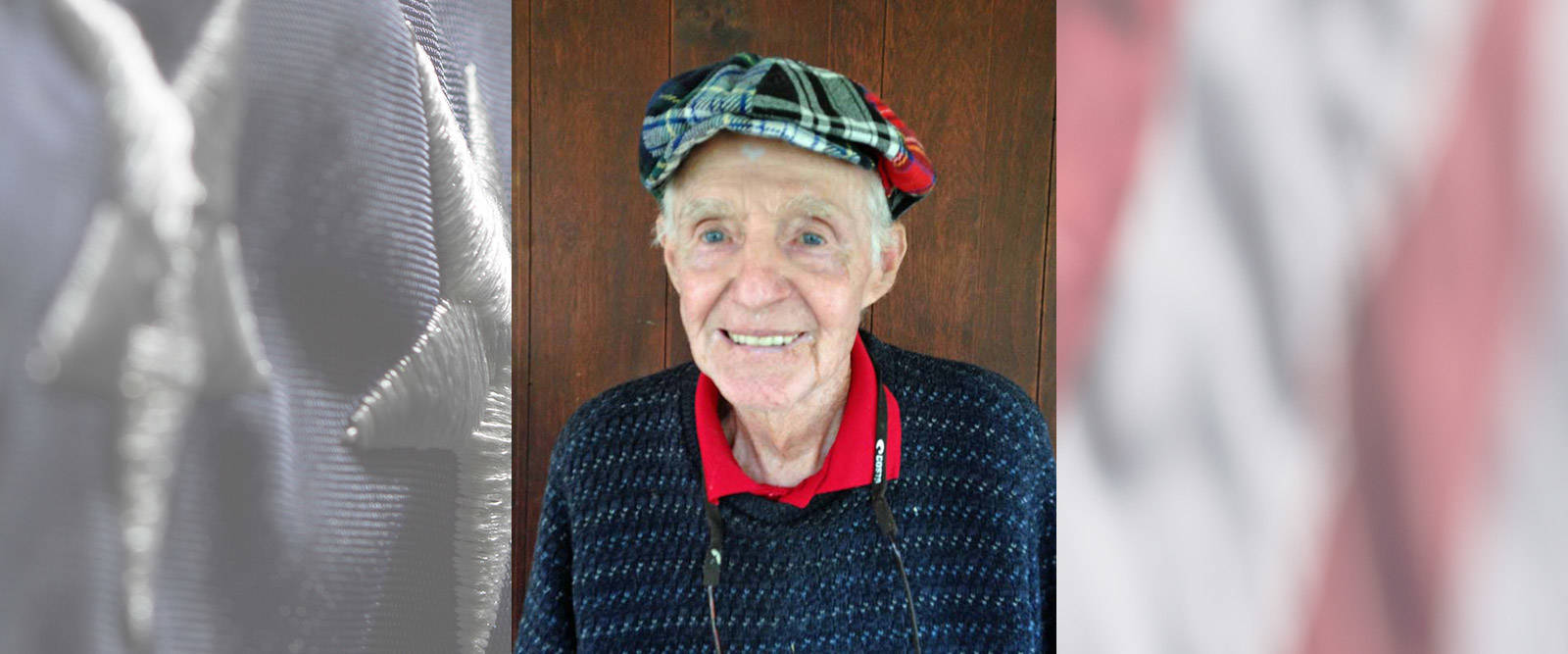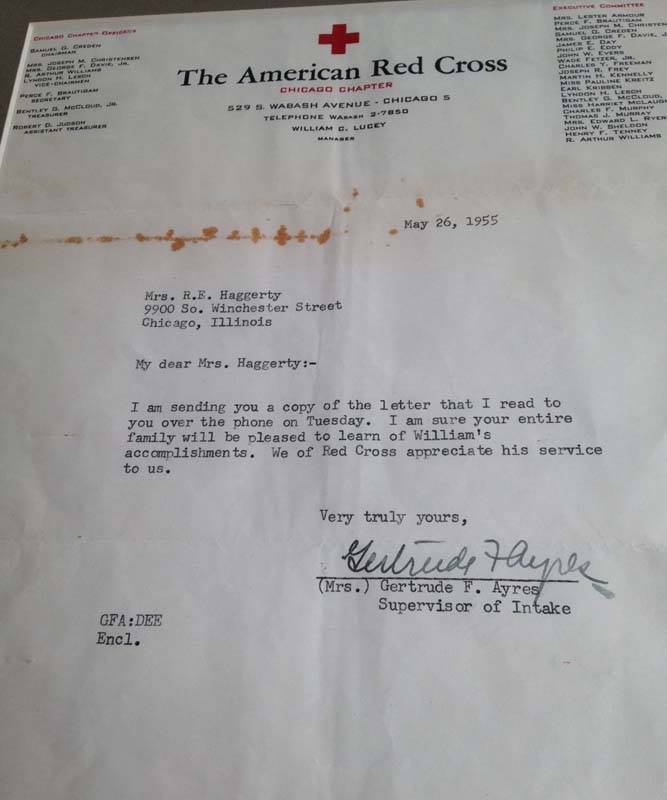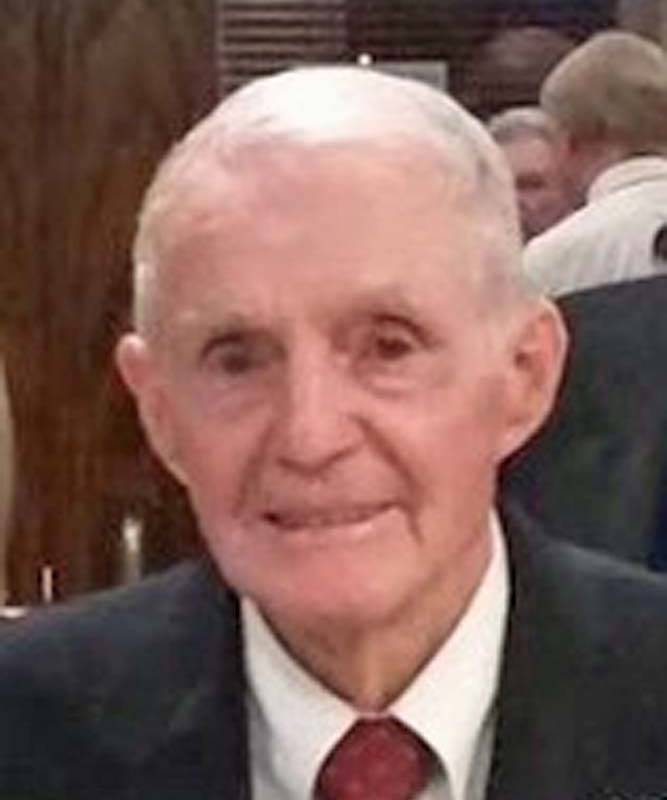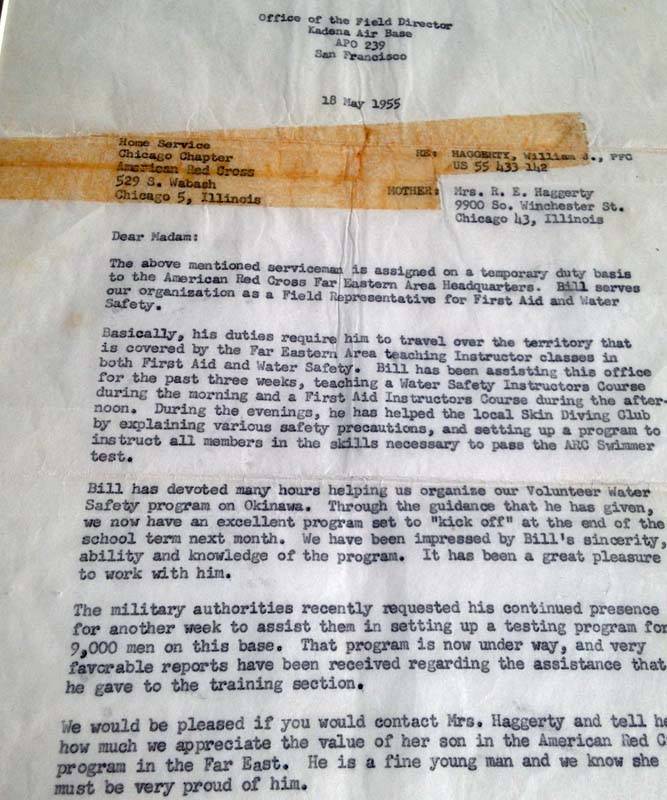U.S. Army Korean War Evergreen Park, IL Flight date: 06/06/18
By Nancy Angel, Honor Flight Chicago Veteran Interviews Volunteer
William “Bill” Haggerty grew up near 99th and Winchester in Beverly, the seventh of twelve children. He spent a great deal of his youth at nearby Ridge Park, participating in many different sports, including swimming at the park pool and diving off the high dive. At Leo High School he competed on the diving team, qualifying for the State finals every year. After graduation from Leo, Bill attended St. Thomas College in St. Paul Minnesota on a partial diving scholarship. From the time Bill was 15 years old, through his college years, he spent his summers lifeguarding for the Chicago Park District. His swimming background provided him a unique way to serve in future years.
In the spring of 1953, Bill earned a degree in business and lost his draft deferral. He was drafted into the Army in July, 1953 and sent to Ft. Leonard Wood for Basic Training. He remembers Basic Training as muddy and awful, but knows that the rigorous training is necessary for teaching the discipline and respect for the chain of command that is necessary in battle. Bill was then sent to Fort Bliss in El Paso, Texas for training as a radar operator. He learned how to monitor radar for enemy aircraft and notify anti-aircraft gunmen by radio. The radar unit that he learned to operate was an AN20 and its radar detection range was only 20 miles! In 1953, there were a number of anti-aircraft sites around the city of Chicago and upon graduation from radar school, Bill was fortunate to be assigned to the anti-aircraft site at 103rd and Cicero in Oak Lawn, IL, just a few miles from his family home. This local Army assignment allowed him to return to his lifeguard job at Kennedy Park.
In September, Bill was transferred to Korea. He travelled by ship and even though he’d been a sailor for many years, he got sick from the stench. The soldiers’ quarters were very tight and the smell was terrible. Bill slept up on deck after the second night. They sailed into Japan where they remained for a day before shipping out to Korea on an LST (Landing Ship Tank.) He was assigned to K-6 Airbase about 70 miles south of Seoul. Bill describes it as a very poor area in the middle of nowhere, where the locals lived in tin sheds with dirt floors. The radar units were stationed around the airbase. Bill didn’t work as a radar operator for long. Bill figured his hunt-and-peck method constituted typing when he volunteered as a typist and was assigned to the supply department.
He enjoyed working in the supply department and recalls the time it required a little creativity and ingenuity. One day, 150 South Korean soldiers came into camp and Bill was assigned to fit them all with boots. Due to the language barrier and a different sizing system, Bill had to figure out what size they needed and fit each man with a pair of boots. With their new boots on, he sent them in groups of 50 on a mile run. He instructed the officers to pull anyone who was limping out of the line, concluding that nobody can run in a pair of poorly fitting boots. He eventually provided each of them with a properly fitting pair of boots.
Bill remembers a memorable trip to Seoul. He received special permission to stay overnight to watch a diving demonstration being put on by US Olympic diver, Dr. Sammy Lee in Seoul. Coincidentally, he knew the pool lifeguards from college competitions. They shared that an American Red Cross representative from Tokyo had been in Seoul looking for instructors – he was definitely interested! He forwarded letters of recommendation he had relating to life-saving from the American Red Cross and the Park District in Chicago. Shortly thereafter, Bill’s entire unit was sent to Tokyo. In Tokyo, Bill interviewed with the American Red Cross and was offered the training job. Of course, his Colonel had to approve a TDY (temporary duty assignment) to the American Red Cross. This meant that Bill was assigned to the American Red Cross for as long as they needed him.
Bill’s assignment was to train men in water safety, including how to prevent themselves from drowning in an island landing when coming off Landing Ship Tanks (LST’s.) According to Bill, the technique is simple, but not something you would do naturally. When the ships landed, the soldiers were let out into about 2 feet of water, maybe 20 yards from shore. While walking to shore with his heavy pack strapped to his back, the soldier may suddenly find himself panicking as he is submerged in 8 feet of water. Unknown to him, the sudden deep water crater he is in was created by the previous shelling of the landing area. The key to rescuing yourself from one of these craters is to drop to your hands and knees and crawl in any direction. Within 8 feet, you will be back in 2 feet of water. Bill taught this simple technique for preventing drowning, as well as general water safety and American Red Cross first aid to officers who in turn would train the GI’s. He taught in Okinawa, all four main islands of Japan, the Philippines and Guam. He taught 35 to 40 classes, staying up to three weeks in each place. He would usually sleep in the hospitals and often ate in the officers’ club. Bill marvels that as a private first class, he was teaching high level Army officers. He wore a civilian suit and bathing suit to work instead of a uniform.
Bill enjoyed this assignment and was commended by the American Red Cross in a letter sent by the Far Eastern Area Headquarters to the Chicago Chapter of the Red Cross, with a request to pass it on to Bill’s mother. The letter recognized his work in teaching water safety, organizing a volunteer water safety program on Okinawa and setting up a testing program for 9,000 men. It stated that “he is a fine young man and we know she (his mother) must be very proud of him.” Who knows how many lives Bill’s training may have saved!
Bill’s ticket home came in the form of the 1956 Olympic trials. U.S. servicemen in Japan were qualifying for swimming and diving, and Bill won platform diving for the Armed Services in the Far East. He was sent to the United States for the 1956 Olympic trials, but came in 10th or 11th, so he didn’t qualify for the Olympics. He was assigned to Fort Sheridan in Illinois for his remaining three months and was honorably discharged from there in May of 1955.
When he got home, Bill took over the business that his brother had started, Haggerty Oil, which provided home delivery of fuel oil, as well as supplying gas pumps for several small companies. Bill liked the work, and especially liked the fact that the business was slower in the summer, so he could enjoy sailing and racing sailboats on weekends. He owned a boat for several years and is proud of being the number one crew on four different large sailboats over a period of 25 years. He recalls very fondly his crew winning a 333 mile Mackinac race by only 7 seconds. He was so proud of that medal, he wore it on his pajamas!
Bill’s wife Eileen was an employee of one of his customers who introduced them. On their first date, he took her to Jackson Park Harbor. They married and raised seven children. After some years, Haggerty Oil closed and Bill worked in several sales jobs, most recently J.S. Pollack for 20 years, until 2000. Bill now enjoys golf, attending daily Mass and spending time with his children, 11 grandchildren and two great-grandchildren.
Thank you Bill for your service and sacrifice during the Korean War. Enjoy your well-deserved day of honor in Washington, D.C.!






